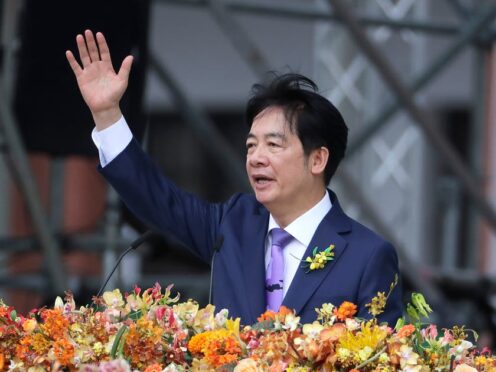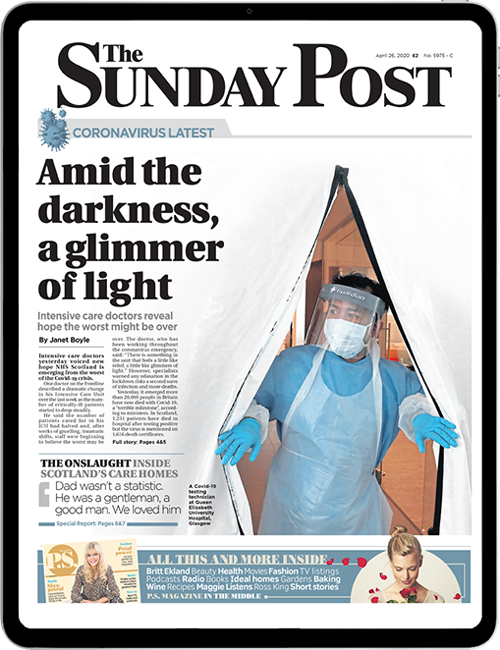
Taiwan’s new President Lai Ching-te has said in his inauguration speech that he wants peace with China and urged it to stop its military threats and intimidation.
After being sworn in, Mr Lai said: “I hope that China will face the reality of (Taiwan)’s existence, respect the choices of the people of Taiwan, and in good faith, choose dialogue over confrontation.”
Mr Lai pledged to “neither yield (to) nor provoke” Beijing, and said he sought peace in relations with China.

But he emphasised the island democracy is determined to defend itself “in the face of the many threats and attempts at infiltration from China”.
Mr Lai’s party, the Democratic Progressive Party, does not seek independence from China but maintains that Taiwan is already a sovereign nation. China claims the self-governing island as part of its territory.
The Chinese office in charge of Taiwan affairs criticised Mr Lai’s speech as promoting “the fallacy of separatism”, inciting confrontation and relying on foreign forces to seek independence.

Chen Binhua, a spokesperson for the Taiwan affairs office of China’s state council, said: “We will never tolerate or condone any form of ‘Taiwan independence’ separatist activities.
“No matter how the situation on the island changes, no matter who is in power, it cannot change the fact that both sides of the Taiwan Strait belong to one China … and cannot stop the historical trend of the motherland’s eventual reunification.
The Chinese ministry of commerce also announced sanctions against Boeing and two other defence companies for arms sales to Taiwan.

Mr Lai, 64, takes over from Tsai Ing-wen, who led Taiwan through eight years of economic and social development despite the Covid-19 pandemic and China’s escalating military threats.
Beijing views Taiwan as a renegade province and has been upping its threats to annex it by force if necessary.
Mr Lai is seen as inheriting Ms Tsai’s progressive policies, including universal health care, backing for higher education and support for minority groups, including making Taiwan the first place in Asia to recognise same-sex marriages.

In his inauguration speech, Mr Lai pledged to bolster Taiwan’s social safety net and help the island advance in fields such as artificial intelligence and green energy.
Mr Lai, who was vice president during Ms Tsai’s second term, came across as more of a firebrand earlier in his career.
In 2017, he described himself as a “pragmatic worker for Taiwan’s independence”, drawing a rebuke from Beijing.

He has since softened his stance and now supports maintaining the status quo across the Taiwan Strait and the possibility of talks with Beijing.
Thousands of people gathered in front of the Presidential Office Building in Taipei for the inauguration ceremony.
Donning white celebratory hats, they watched the swearing-in on large screens, followed by a military march and colourful performances featuring folk dancers, opera performers and rappers. Military helicopters flew in formation, carrying Taiwan’s flag.
Mr Lai accepted congratulations from fellow politicians and delegations from the 12 nations that maintain official diplomatic relations with Taiwan, as well as politicians from the US, Japan and various European states.

Mr Lai, also known by his English name William, has vowed to continue his predecessor’s push to maintain stability with China while beefing up Taiwan’s security through imports of military equipment from close partner the US, the expansion of the defence industry with the manufacture of submarines and aircraft, and the reinforcing of regional partnerships with unofficial allies such as America, Japan, South Korea and the Philippines.
US secretary of state Antony Blinken congratulated Mr Lai on his inauguration, saying: “We look forward to working with President Lai and across Taiwan’s political spectrum to advance our shared interests and values, deepen our longstanding unofficial relationship, and maintain peace and stability across the Taiwan Strait.”
The US does not formally recognise Taiwan as a country but is bound by its own laws to provide the island with the means to defend itself.

Enjoy the convenience of having The Sunday Post delivered as a digital ePaper straight to your smartphone, tablet or computer.
Subscribe for only £5.49 a month and enjoy all the benefits of the printed paper as a digital replica.
Subscribe